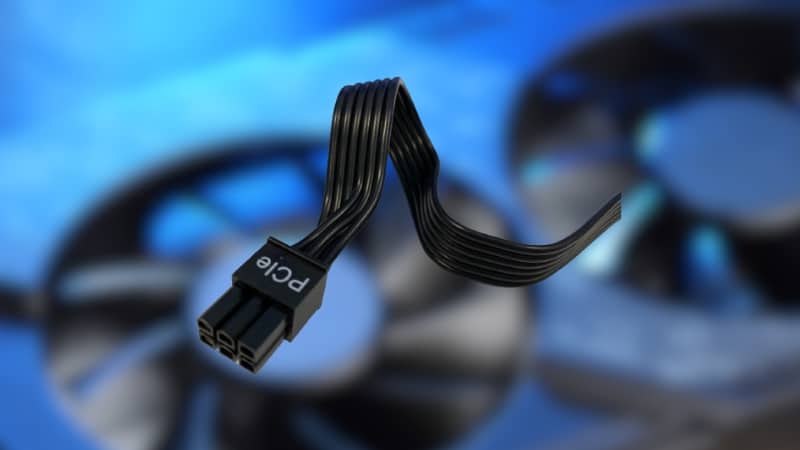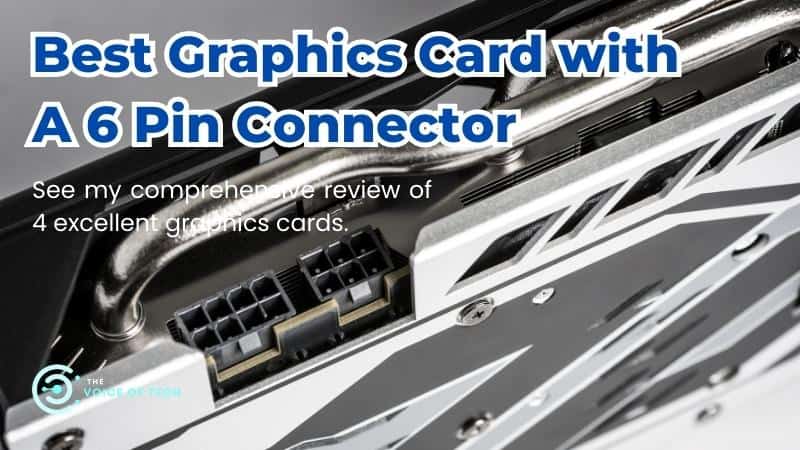
Expert Consulted: Adrian Gardiner. Years of experience buying both computers and computer parts for my own new customer builds has given me a keen eye for spotting great deals when shopping. In this article, I’ll be sharing my knowledge to help you find the best graphics card with 6 pin connector.
If you’re looking to upgrade the graphics capability on your PC, but your PSU only has a 6-pin connector, whilst your choices might be limited, there are still some excellent graphics card options out there for you to choose from.
In this guide, I’ve found four excellent graphics cards that will all work with a 6-pin connector and one that doesn’t even need a power cable connection (Option 3).
This post contains affiliate links. Click here to read our affiliate policy.
Best Graphics Card with 6 Pin Connector – 4 Reviewed
After having a very in-depth look around to see what’s available in the 6-pin GPU world, I found four great options for you to choose from, all still currently available on the market and at a good range of prices to suit every pocket.
The following table highlights the Graphics Card options reviewed for you:
| Option | Reason for Selection | |
| 1. | ASUS TUF Gaming AMD Radeon 6500 XT | ‘Best Specification’ |
| 2. | NVIDIA GTX 1650 | ‘Compact Option’ |
| 3. | NVIDIA GTX 1050 Ti | ‘Low Profile Option’ |
| 4. | AMD Radeon RX 580 | ‘Budget Option’ |
No. 1 – ASUS TUF Gaming AMD Radeon RX 6500 XT – ‘Best Specification’
Released in 2022, the AMD RX 6500 XT was brought out to compete with the NVIDIA RTX 3050.
Featuring 4 GB of GDDR6 RAM based on the RDNA 2 architecture and supporting DirectX 12 Ultimate, this card was designed purely for gaming and can support 4K resolution.
The vast majority of the top games available should be playable at the recommended or very best experience levels with this superb card.
The full specification is as follows:
- Video Memory (RAM): 4 GB GDDR6
- Bus Type: PCIe 4.0 x 16
- Clock Speed: 2685 – 2825 MHz
- Video Output Interface: 1 x DisplayPort 1.4a, 1 x HDMI 2.1
- LED Lighting: Yes (Aura Sync)
- Power Draw (TDP): Not specified
- Recommended PSU: 500w
- Dimensions (LxWxH): 9.76 x 2.12 x 5.78″
- Power Connectors: 1 x 6 Pin
PROs
ARGB Aura Sync Lighting
DirectX 12 Ultimate support
All aluminium shroud and backplate enhance durability
CONs
Ideally, a bit more RAM would be nice, but it’s not the end of the world for such a great card.
No. 2 – NVIDIA GeForce GTX 1650 – ‘Compact Option’
An ever-popular and very affordable gaming choice of old and still even today for the budget-conscious, the NVIDIA GeForce GTX 1650 was launched in 2019 and still performs well.
Also, like the GTX 1050 Ti, it has a low power draw but does need a 6-pin connector.
Its compact size makes it ideal for lower-powered systems with little space for upgrades.
Again, it will naturally not play AAA games on high but is perfectly capable of playing most games out there at decent resolutions and with reasonable FPS if you’re prepared to tweak the game settings.
Although there are better cards out there for not much more money, like the RTX 2060, they will all have higher power requirements, also needing 8-pin or higher power connectors.
The full specification is as follows:
- Video Memory (RAM): 4 GB GDDR6
- Bus Type: PCIe 3.0 x 16
- Clock Speed: 1635 MHz
- Video Output Interface: 1 x DisplayPort 1.4, 1 x HDMI 2.0b, 1 x DVI-D
- Power Draw (TDP): Not specified
- Recommended PSU: 300w
- Dimensions (LxWxH): 172 x 40 x 122 mm
- Power Connectors: 1 x 6 Pin
Pros
Compact size
Lower power draw
Turing Architecture
Can still play today’s games.
Cons
Apart from it’s age, none.
No. 3 – NVIDIA GeForce GTX 1050 Ti – ‘Low Profile Option’
Released in October 2016, the NVIDIA GeForce GTX 1050 Ti has a low TDP rating of only 75w, which means it doesn’t need a separate power connector.
Combined with this low TDP and its compact, low-profile size, it makes an ideal and affordable GPU upgrade for smaller builds with less capable power supplies.
Although the GTX 1050 Ti is now starting to show its age a bit, it still has the ability to run many games at high settings.
Of course, expecting it to handle the very latest AAA titles at high settings without the chance of some lag is probably a bit too much.
However, all things considered, this is still an amazingly versatile card for those on a budget.
- Video Memory (RAM): 4 GB GDDR5
- Bus Type: PCIe 3.0 x 16
- Clock Speed: 1290 / 1392 MHz
- DirectX: 12
- Video Output Interface: 1 x DisplayPort 1.4a, 1 x DVI-D, 1 x HDMI 2.0b
- Power Draw (TDP): 75w
- Recommended PSU: 300w
- Dimensions (LxWxH): 182 x 35 x 69 mm
- Power Connectors: Not required
PROs
G-Sync Support
Low profile bracket provided
No power connector required
Low TDP of only 75w
Good for 1080p gaming.
CONs
It’s starting to show its age a bit.
No. 4 – AMD Radeon RX 580 – ‘Budget Option’
Launched in the performance gaming sector in June 2016 to compete with the NVIDIA GTX 1060, the competitively specified AMD Radeon RX 580 is an excellent budget choice.
Equipped with 8 GB of RAM and DirectX 12 capable, it’s still capable of running many top-tier games at high settings.
With a low power draw and the need for a 6-pin power connector, this card will suit those either new to gaming or just looking to upgrade to a smaller system with limited power output.
While this card will likely struggle with 4k gaming, it has shown good results with 1080p and 1440p gaming with many popular games.
The full specification is as follows:
- Video Memory (RAM): 8 GB GDDR5
- Bus Type: PCIe 3.0 x 16
- Clock Speed: 1244 MHz
- Direct X: 12
- Video Output Interface: 2 x DisplayPort 1.4a, 1 x HDMI 2.0b
- LED Lighting: n/a
- Power Draw (TDP): 150w
- Recommended PSU: 500w
- Dimensions (LxWxH): 235 x 43 x 135 mm
- Power Connectors: 1 x 6 Pin
Pros
Huge 8 GB of GDDR5 RAM
DirectX 12 support
Excellent cooling system with intelligent fans that stop running when temps are low
Cons
None.
The 6 Pin Power Connector

The 12v 6-pin power connector is designed to deliver up to 75 watts from your power supply unit (PSU), enough for low to mid-range graphics cards. For reference, an 8-pin cable would be rated to provide up to 150w.
When combined with the power available directly from a PCIe slot, also capable of providing 75w, you have a total of 150w at your disposal to drive your GPU.
Many larger and more powerful GPUs require more power and get this via a range of different power connectors, depending on the card in question. These connectors can be 2 x 6 pin, 1 x pin with 1 x 8 pin, or 2 x 8 pin.
All of these connectors would mean purchasing a PSU that comes a) with the correct power rating for your system and b) with the correct cables to cater to your particular setup and chosen GPU.
Purchase Considerations When Selecting a Graphics Card with 6 Pin Connector
When looking to buy the best graphics card with 6 pin connector, I’d recommend taking the following into account:
- Power Consumption – Make sure that your PSU can handle the power drawn from your chosen GPU. This would be the TDP specified in watts by your GPU supplier. Many GPU suppliers will also state the minimum recommended PSU wattage.
- GPU Compatibility with PSU – Check to make sure that the required power connector on your GPU is supported with the right power connector cable on your PSU (i.e., a 6-pin connector in our case)
- Case Support – It’s worth checking to make sure that your computer case has room to fit the card you’ve chosen.
Installing the Best Graphics Card with 6 Pin Connector
Installation of your GPU is usually pretty straightforward:
- Make sure you have your GPU power cable and connector in the right place inside your PC case, ready to connect up.
- Remove the right number of slot covers at the rear of your PC to suit your graphics card. Most cards take up either 2 or 3 slots.
- Carefully line up your GPU and lower it into its PCIe socket on the motherboard (this will usually be the uppermost PCIe socket if you have more than one). Once it’s lined up and resting in the top of the socket, it will need a firm push to get the card properly seated all the way down. When you apply this final push, try not to let the card move from side to side as you press down. You’ll hear a slight ‘click’ as the card is seated to let you know it’s done.
- Secure the card with the appropriate number of slot screws
- Plug in your power connector cable.
Frequently Asked Questions
Q1 Why do different graphics cards have different power connectors?
As different GPUs have differing power requirements, they need a power connector cable that is rated for the correct power. For example, a 6-pin connector is rated for 75w, and an 8-pin is rated for 150w.
As graphics cards continue to become more powerful, their TDP power ratings continue to increase, meaning that the power connector cable standards have to change to keep up, resulting in ever-changing power connectors.
Q2 Can I use an 8-pin connector on a graphics card that requires a 6-pin connector?
Ideally, I would always use the correct connector that was designed for the job. However, if you have an 8-pin connector coming directly from your PSU and you want to use it for a 6-pin socket on your GPU, that’s usually perfectly fine.
Q3 What happens when my graphics card doesn’t get enough power?
Insufficient power can result in all sorts of unwanted symptoms, including:
- Your PC failing to start
- Lockups while running
- No display while running
- Display problems while running
- Complete system crashes.
In such a case, I always recommend upgrading to a larger capacity PSU a) to ensure your system runs smoothly and b) to eliminate the possibility of hardware damage.
Conclusion
The 6-pin connector has been with us for quite a while now, and considering graphics cards are becoming more and more capable and drawing more power, I was surprised to see so many 6-pin GPU options still available.
There are 6 to 8-pin power connector adapters out there to overcome the lack of an 8-pin connector on your PSU, but I’d like to sound a note of caution here as there have been reports of these adapters causing serious issues (i.e., cables melting and damaged GPUs). My advice would be to avoid using these if at all possible.
The cards reviewed above are all capable of giving you a great gaming experience and a good chance of fitting in your PC, too, with their 6-pin connectors, lower TDP ratings, and compact designs.
Out of those reviewed, I would select Option 1, the AMD Radeon RX 6500 XT, if only because it’s the most current and has the best specification for gaming performance.





